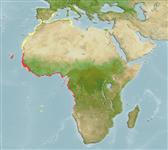Scomberomorus tritor (Cuvier, 1832)
West African Spanish mackerel
Add your observation in Fish Watcher
| Native range | All suitable habitat | Point map | Year 2050 |

|
| This map was computer-generated and has not yet been reviewed. |
| Scomberomorus tritor AquaMaps Data sources: GBIF OBIS |
Upload your photos and videos
Pictures | Google imageScomberomorus tritor
Picture by JJPhoto
Pictures | Google imageScomberomorus tritor
Picture by JJPhoto
Common names from other countries
Classification / Names Populärnamn | synonymer | Catalog of Fishes(Släkte, Arter) | ITIS | CoL | WoRMS | Cloffa
> Scombriformes (Mackerels) > Scombridae (Mackerels, tunas, bonitos) > Scombrinae
Etymology: Scomberomorus: Latin, scomber = mackerel + Greek, moros = silly, stupid (Ref. 45335).
More on author: Cuvier.
Etymology: Scomberomorus: Latin, scomber = mackerel + Greek, moros = silly, stupid (Ref. 45335).
More on author: Cuvier.
Environment: milieu / climate zone / depth range / distribution range Ekologi
marina; brackvatten; havsvandrande (Ref. 51243); djupintervall 1 - 40 m (Ref. 28173), usually 20 - 25 m (Ref. 28173). Tropical; 45°N - 19°S, 24°W - 14°E (Ref. 168)
Utbredning Länder | FAO områden | Ekosystem | Förekomster | Point map | Utplanteringar | Faunafri
Eastern Atlantic: Canary Islands and Senegal to the Gulf of Guinea and Baía dos Tigres, Angola. Rarely found in the northern Mediterranean Sea, along the coasts of France and Italy. This species has been erroneously been considered as a synonym of Scomberomorus maculatus by many authors.
Length at first maturity / Size / Vikt / Age
Maturity: Lm 37.3, range 33 - 45 cm
Max length : 100.0 cm TL hane/ej könsbestämd; (Ref. 2683); 98.0 cm FL (female); common length : 75.0 cm TL hane/ej könsbestämd; (Ref. 2683); publicerad maxvikt: 6.0 kg (Ref. 40637); rapporterad maxålder: 5 år (Ref. 27160)
Max length : 100.0 cm TL hane/ej könsbestämd; (Ref. 2683); 98.0 cm FL (female); common length : 75.0 cm TL hane/ej könsbestämd; (Ref. 2683); publicerad maxvikt: 6.0 kg (Ref. 40637); rapporterad maxålder: 5 år (Ref. 27160)
Short description Bestämningsnycklar | Morfologi | Morfometri
Taggstrålar i ryggfenan (totalt) : 15 - 18; Mjukstrålar i ryggfenan (totalt) : 0; Mjukstrålar i analfenan: 17 - 20; Ryggkotor: 46 - 47. Interpelvic process small and bifid. Body covered with small scales. Lateral line gradually curving down toward caudal peduncle. Intestine with 2 folds and 3 limbs. Swim bladder absent. Some large individuals with thin vertical bars. Anterior half of first dorsal fin and margin of posterior half of first fin black.
Inhabits warm waters (Ref. 2683). Forms school close to the shore (Ref. 9987). Enters coastal lagoons and feeds on clupeids particularly Ethmalosa fimbriata. Reproduces in July to August (Ref. 5377). Eggs and larvae are pelagic (Ref. 6769). Utilized fresh, dried-salted, smoked and frozen (Ref. 9987).
Life cycle and mating behavior Könsmognad | Reproduktion | Lek | Ägg | Fecundity | Larver
Main reference
Upload your references | referenser | Koordinator : Collette, Bruce B. | Medarbetare
Collette, B.B. and C.E. Nauen, 1983. FAO Species Catalogue. Vol. 2. Scombrids of the world. An annotated and illustrated catalogue of tunas, mackerels, bonitos and related species known to date. Rome: FAO. FAO Fish. Synop. 125(2):137 p. (Ref. 168)
Threat to humans
Harmless
Human uses
Fiskeri: kommersiell; sportfisk: ja
FAO(fiskeri: produktion; publication : search) | FishSource | Sea Around Us
Ytterligare information
Population dynamics
Tillväxtparametrar
Max. ages / sizes
Length-weight rel.
Length-length rel.
Length-frequencies
Mass conversion
Rekrytering
Abundans
Tillväxtparametrar
Max. ages / sizes
Length-weight rel.
Length-length rel.
Length-frequencies
Mass conversion
Rekrytering
Abundans
Life cycle
Reproduktion
Könsmognad
Fecundity
Lek
Spawning aggregations
Ägg
Egg development
Larver
Larvdynamik
Reproduktion
Könsmognad
Fecundity
Lek
Spawning aggregations
Ägg
Egg development
Larver
Larvdynamik
Anatomy
Gälyta
Brain
Otolith
Gälyta
Brain
Otolith
Physiology
Body composition
Nutrients
Syreförbrukning
Swimming type
Simhastighet
Visual pigments
Fish sound
Diseases & Parasites
Toxicity (LC50s)
Body composition
Nutrients
Syreförbrukning
Swimming type
Simhastighet
Visual pigments
Fish sound
Diseases & Parasites
Toxicity (LC50s)
Genetics
Genetik
Heterozygosity
Ärftlighet
Genetik
Heterozygosity
Ärftlighet
Human related
Aquaculture systems
Vattenbruksprofiler
Avelslinjer
Ciguatera cases
Stamps, coins, misc.
Aquaculture systems
Vattenbruksprofiler
Avelslinjer
Ciguatera cases
Stamps, coins, misc.
Verktyg
E-book | Fälthandbok | Längdfördelnings-verktyg | Livshistorie-verktyg | Prickkarta | Classification Tree
| Catch-MSY |
Special reports
Download XML
Internet-källor
Aquatic Commons | BHL | Cloffa | Websites from users | Check FishWatcher | CISTI | Catalog of Fishes(Släkte, Arter) | DiscoverLife | ECOTOX | Faunafri | Fishtrace | GenBank(genome, nucleotide) | GloBI | GOBASE | | Google Books | Google Scholar | Google | IGFA World Record | MitoFish | Nationella databaser | Otolith Atlas of Taiwan Fishes | PubMed | Reef Life Survey | Scirus | SeaLifeBase | Tree of Life | Wikipedia(Go, sök) | World Records Freshwater Fishing | Zoological Record
Estimates based on models
Preferred temperature (Ref. 115969): 22.7 - 27.7, mean 25.9 (based on 10 cells).
Phylogenetic diversity index (Ref. 82804): PD50 = 0.5000 [Uniqueness, from 0.5 = low to 2.0 = high].
Bayesian length-weight: a=0.00832 (0.00511 - 0.01354), b=3.02 (2.89 - 3.15), in cm Total Length, based on LWR estimates for this species & Genus-body shape (Ref. 93245).
Trofisk nivå (Ref. 69278): 4.4 ±0.8 se; based on diet studies.
Resiliens (Ref. 120179): Mellan, lägsta populationsfördubblingstid 1,4-4,4 år (K=0.31-0.33; tmax=5; Fec=1 million).
Prior r = 0.39, 95% CL = 0.26 - 0.59, Based on 1 data-limited stock assessment.
Fishing Vulnerability (Ref. 59153): Moderate vulnerability (38 of 100).
Climate Vulnerability (Ref. 125649): High vulnerability (60 of 100).




